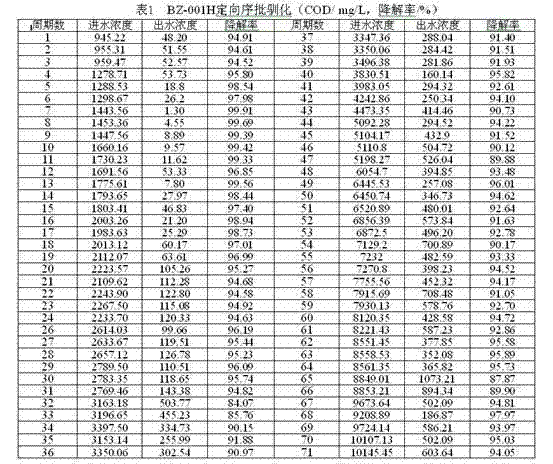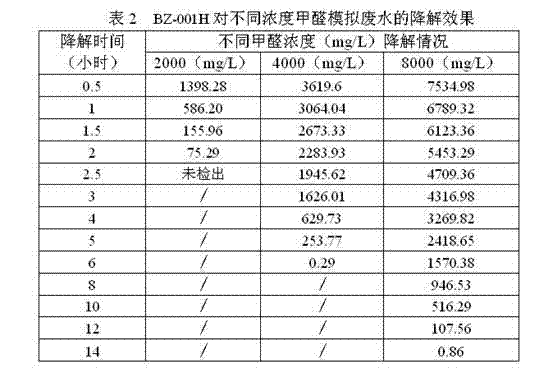High-efficiency formaldehyde degrading bacteria and use and using method thereof
A formaldehyde-degrading bacteria and high-efficiency technology, applied in chemical instruments and methods, biochemical equipment and methods, and microbial-based methods, can solve the problems of slow degradation rate, high biological toxicity, and difficult microbial degradation, and achieve fast degradation speed , strong tolerance, and simple fermentation and cultivation methods
- Summary
- Abstract
- Description
- Claims
- Application Information
AI Technical Summary
Problems solved by technology
Method used
Image
Examples
Embodiment 1
[0011] Example 1: Screening and isolation of formaldehyde-degrading bacteria BZ-001H, domestication and treatment of formaldehyde wastewater
[0012] Collect activated sludge from the aerobic pool of Chengdu No. 1 Sewage Treatment Plant, inoculate 100ml of formaldehyde in selective medium (0.05%) according to 10% inoculum amount, carry out plate streak separation and purification, and screen to obtain formaldehyde that can use formaldehyde as a carbon source for growth. strain. The domestication of the strain adopts the directional intermittent domestication method of gradually increasing the formaldehyde concentration in the medium.
[0013] Synthetic Medium (MSB): Contains Na per 1L 2 HPO 4 2g, KH 2 PO 4 0.5g, MgSO 4 ·7H 2 O 0.3 g, (NH 4 ) 2 SO 4 0.5 g, trace element solution 5mL, formaldehyde 1g. Add 15 g / L agar powder to the solid medium.
[0014] After the sludge sample is enriched and cultured, a mixed microbial culture is obtained, which can grow with fo...
Embodiment 2
[0024] Example 2: BZ-001H different inoculum amounts Enhanced treatment system for high concentration formaldehyde waste liquid
[0025] After the BZ-001H strain was expanded and cultivated, the BZ-001H strain was inoculated according to the gradient (0.05‰, 0.1‰, 0.2‰, 0.3‰, 0.5‰, 0.7‰) of different inoculum amounts (based on dry cell weight of the strain) to the conventional An enhanced treatment system was constructed in the activated sludge treatment system (MLSS=2 000 ±100 mg / L), and 4356.7 mg / L of formaldehyde was added to domestic sewage to make a simulated waste liquid of sudden pollution accident, 30 ℃, 160 rmin -1 Cultivate on a shaking table, and take samples after 6 hours to measure the degradation of formaldehyde to determine the optimal inoculum size.
[0026]
[0027] The results in Table 3 show that the degradation of 4356.7 mg / L formaldehyde by BZ-001H, after 6 hours of degradation, the removal rate of formaldehyde in the waste liquid with the inoculation...
Embodiment 3
[0028] Example 3: Effects of pH on Formaldehyde Waste Liquid Treatment by BZ-001H Intensive Treatment System
[0029] Inoculate 0.3‰ BZ-001H strain (based on dry cell weight) in a conventional activated sludge treatment system (MLSS=2000 ± 100 mg / L) to construct an enhanced treatment system, and add a certain amount of formaldehyde to domestic sewage to make 2000 mg / L, 4000 mg / L, 8000 mg / L formaldehyde sudden pollution accident simulation waste liquid, the simulation experiment is divided into two groups, one group is the control treatment system that maintains the pH change of the treatment system itself, and the second group is every 0.5 h Use 10% NaOH solution to adjust the pH of the treatment system to 6.0-8.0. The treatment system numbers are 1, 2, 30 ℃, 160r / min shaker culture, and samples are taken every 0.5h, 1h, and 2h to determine the pH of each Treat the pH in the system and the formaldehyde content in it.
[0030]
[0031] The results show that the control o...
PUM
| Property | Measurement | Unit |
|---|---|---|
| clearance rate | aaaaa | aaaaa |
Abstract
Description
Claims
Application Information
 Login to View More
Login to View More - R&D
- Intellectual Property
- Life Sciences
- Materials
- Tech Scout
- Unparalleled Data Quality
- Higher Quality Content
- 60% Fewer Hallucinations
Browse by: Latest US Patents, China's latest patents, Technical Efficacy Thesaurus, Application Domain, Technology Topic, Popular Technical Reports.
© 2025 PatSnap. All rights reserved.Legal|Privacy policy|Modern Slavery Act Transparency Statement|Sitemap|About US| Contact US: help@patsnap.com



